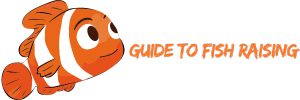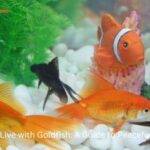Observing a fish swimming head down tail up can be concerning for any aquarist. This unusual behavior often indicates an underlying issue that requires attention. This article Guide to Fish Raising provides an in-depth exploration of the causes, prevention, and treatment of this condition, helping you ensure the health and well-being of your aquatic pets.
Table of contents
ToggleCauses of Fish Swimming Head Down Tail Up
Swim Bladder Disorder
Description: The swim bladder is an internal gas-filled organ that helps fish maintain buoyancy. Swim bladder disorder occurs when this organ malfunctions, causing the fish to lose its balance.
Symptoms: Fish may swim erratically, float upside down, or struggle to maintain a normal position. In severe cases, the fish might swim head down, tail up.
Causes: This condition can be caused by several factors, including overfeeding, constipation, infection, or physical injury. Poor water quality and sudden changes in water parameters can also contribute to swim bladder issues.
Constipation
Description: Constipation is a common issue in aquarium fish, often resulting from an improper diet.
Symptoms: Fish may have a swollen abdomen, reduced appetite, and difficulty swimming. They might also produce stringy or absent feces.
Causes: Overfeeding and feeding inappropriate foods, such as those lacking in fiber, can lead to constipation. Low-quality or old food can also contribute to digestive problems.
Parasites and Infections
Description: Parasites and bacterial infections can disrupt a fish’s ability to swim normally.
Symptoms: In addition to abnormal swimming, infected fish may exhibit lethargy, loss of appetite, visible parasites on the body, or other signs of distress.
Causes: Poor water quality, contaminated live food, and introducing infected fish to the tank can spread parasites and infections. Common parasites include Ichthyophthirius multifiliis (Ich) and flukes.
Physical Injury
Description: Physical trauma can damage a fish’s swim bladder or other internal organs, affecting its ability to swim properly.
Symptoms: Fish may display erratic swimming patterns, visible wounds, or bruising. Injured fish might also isolate themselves from other tank inhabitants.
Causes: Injuries can result from aggressive tank mates, rough handling, or collisions with tank decorations. Sharp objects and tight spaces within the aquarium can also pose risks.
Nutritional Deficiencies
Description: A lack of essential nutrients can impact a fish’s overall health and buoyancy control.
Symptoms: Fish may appear lethargic, have faded colors, and exhibit abnormal swimming behaviors. Poor growth and weakened immune systems are also common.
Causes: Feeding a monotonous diet lacking in variety and essential nutrients can lead to deficiencies. Ensuring a balanced diet with high-quality foods is crucial for preventing nutritional issues.
Prevention of Fish Swimming Head Down Tail Up
Maintain Optimal Water Quality
Regular Testing: Test water parameters regularly, including ammonia, nitrite, nitrate, pH, and temperature. Maintain stable conditions within the appropriate range for your fish species.
Water Changes: Perform regular water changes to remove accumulated waste and toxins. Aim for a 20-25% water change weekly or as needed, depending on the bioload of your tank.
Filtration: Ensure your aquarium has an efficient filtration system that provides mechanical, chemical, and biological filtration. Clean or replace filter media as needed to maintain optimal performance.
Proper Feeding Practices
Balanced Diet: Provide a varied diet that meets the nutritional needs of your fish. Include high-quality pellets, flakes, frozen, and live foods. Avoid overfeeding and remove uneaten food promptly.
Feeding Schedule: Feed your fish small, frequent meals rather than one large feeding. This helps prevent constipation and reduces the risk of overeating.
Pre-soaked Food: Pre-soak dry food before feeding to prevent it from expanding in the fish’s stomach, reducing the risk of swim bladder issues.
Quarantine New Additions
Isolation: Quarantine new fish and invertebrates for at least two weeks before introducing them to the main tank. This helps prevent the spread of diseases and parasites.
Observation: Monitor quarantined fish for signs of illness or abnormal behavior. Treat any issues promptly before transferring the fish to the main tank.
Reduce Stress
Tank Mates: Choose compatible tank mates to minimize aggression and stress. Avoid overcrowding the tank, as it can lead to territorial disputes and poor water quality.
Environment: Provide hiding spots and a well-decorated tank to create a stress-free environment. Ensure the tank size and setup meet the specific needs of your fish species.
Handling: Handle fish gently and avoid unnecessary disturbances. Use a soft net and minimize the time fish spend out of water during transfers or tank maintenance.

Treatment of Fish Swimming Head Down Tail Up
Swim Bladder Disorder Treatment
Fasting: If overfeeding is suspected, fast the affected fish for 24-48 hours to allow its digestive system to clear. Resume feeding with a high-fiber food like cooked peas (without the skin).
Medication: In cases of bacterial infection, use a broad-spectrum antibiotic recommended for aquarium use. Follow the dosage instructions carefully.
Epsom Salt Bath: Administer an Epsom salt bath (1 tablespoon of Epsom salt per gallon of water) for 15-30 minutes to help relieve swelling and constipation.
Constipation Treatment
Dietary Changes: Incorporate high-fiber foods like peas or daphnia into the diet to promote digestion. Avoid feeding dry foods that expand in the stomach.
Fasting: Fast the fish for 24-48 hours to allow the digestive system to clear. Resume feeding with easily digestible foods in small portions.
Parasite and Infection Treatment
Medication: Use appropriate medications to treat parasites or bacterial infections. Common treatments include copper-based medications for parasites and antibiotics for bacterial infections.
Isolation: Isolate infected fish in a quarantine tank to prevent the spread of disease. Treat the main tank to eliminate any remaining parasites or bacteria.
Water Quality: Improve water quality through frequent water changes and proper filtration to support the healing process.
Physical Injury Treatment
Remove Aggressors: Identify and remove aggressive tank mates that may be causing injuries. Provide ample hiding spots and a stress-free environment.
Medicate: Treat visible wounds with an antiseptic or antibacterial medication to prevent secondary infections. Monitor the injured fish closely for signs of improvement.
Nutritional Deficiencies Treatment
Balanced Diet: Offer a varied and balanced diet that meets the nutritional needs of your fish. Include high-quality commercial foods, live foods, and supplements as needed.
Vitamin Supplements: Consider adding vitamin supplements to the diet to address specific deficiencies. Consult with an aquatic veterinarian for recommendations.
Case Studies and Real-Life Experiences
Case Study 1: Swim Bladder Disorder in a Goldfish
A hobbyist noticed their goldfish swimming head down tail up and struggling to maintain balance. Upon researching, they suspected swim bladder disorder caused by overfeeding. The hobbyist fasted the goldfish for 48 hours and then fed it cooked peas. Within a week, the goldfish’s buoyancy improved, and it resumed normal swimming.
Case Study 2: Constipation in a Betta Fish
A betta fish owner observed their fish exhibiting a swollen abdomen and difficulty swimming. The owner realized they had been overfeeding dry pellets. They fasted the betta for 24 hours and then introduced pre-soaked high-fiber foods. The betta’s condition improved, and it began swimming normally within a few days.
Case Study 3: Parasite Infestation in a Community Tank
An aquarist noticed white spots on multiple fish in their community tank. Suspecting a parasite infestation, they set up a quarantine tank and treated the affected fish with a copper-based medication. They also improved water quality through frequent water changes. The fish recovered, and the main tank was treated to eliminate any remaining parasites.
Conclusion
Observing a fish swimming head down tail up can be a sign of underlying health issues that require prompt attention. By understanding the common causes, implementing preventive measures, and applying appropriate treatments, aquarists can ensure the health and well-being of their fish. Maintaining optimal water quality, providing a balanced diet, and reducing stress are essential practices for preventing and addressing this condition. Through diligent care and observation, you can create a thriving and harmonious aquatic environment for your fish.





